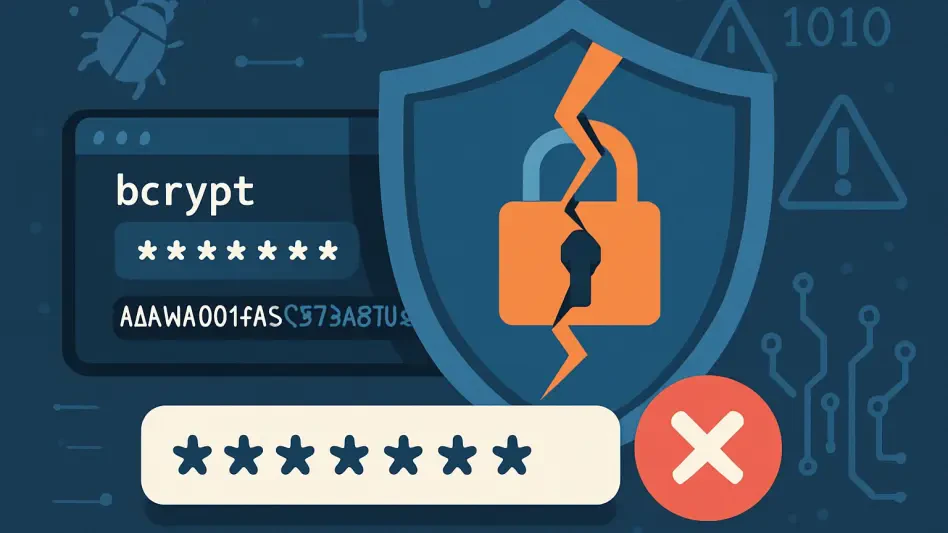Imagine a fortress, long considered impregnable, guarding the digital keys to countless systems, only to reveal a hidden crack in its foundation that could let intruders slip through unnoticed, posing a severe threat to cybersecurity. Bcrypt, a password hashing algorithm introduced in 1999 and built on the Blowfish cipher, has been that fortress for decades, lauded for its slow, resource-intensive design that thwarts brute-force attacks. Its adjustable iteration counts and built-in salting to prevent rainbow table exploits have made it a staple in securing platforms like OpenBSD and various Linux distributions. Yet, a subtle flaw tied to its 72-byte input limitation, inherited from Blowfish’s key schedule, poses a significant risk by truncating longer inputs and potentially weakening security. As technology races forward with powerful GPUs and AI-driven cracking tools, this vulnerability, often overlooked, demands attention. The evolving cybersecurity landscape, coupled with competition from newer algorithms, raises critical questions about bcrypt’s place in modern defenses and how to safeguard systems relying on it.
Unpacking Bcrypt’s Design and Legacy
The Strength of Deliberate Slowness
Bcrypt’s enduring appeal stems from its intentional design to be computationally slow, a trait that makes each password guess a time-consuming ordeal for attackers. Unlike faster algorithms that can be exploited through rapid attempts, bcrypt’s structure demands significant CPU resources, amplified by adjustable work factors that increase the effort required as hardware improves. This slowness, combined with its resistance to parallel processing on GPUs due to memory contention, creates a formidable barrier against brute-force attacks. Its integration into trusted systems over the years has cemented a reputation for reliability, with many developers viewing it as a battle-tested solution. Academic discussions and industry feedback consistently highlight how this approach has protected sensitive data across diverse environments, from web applications to server authentication protocols, by ensuring that cracking even a single hash remains a daunting task for unauthorized parties.
Beyond its core design, bcrypt’s automatic salting mechanism adds another layer of defense, neutralizing threats like rainbow table attacks where precomputed hash lists are used to reverse-engineer passwords. Each password is paired with a unique salt, ensuring that identical inputs yield different hashes, a feature that has been praised in cybersecurity communities for its simplicity and effectiveness. This built-in randomness, alongside the algorithm’s maturity, has made it a preferred choice for developers seeking a straightforward yet robust hashing method. Historical adoption in open-source projects and major operating systems reflects confidence in its ability to withstand common attack vectors. However, while these strengths have sustained bcrypt’s relevance, they also mask underlying limitations that become more pronounced as digital threats evolve and computational power surges, prompting a closer examination of its suitability for today’s security needs.
Historical Significance in Password Protection
Tracing bcrypt’s journey reveals its pivotal role in shaping password security standards since its inception over two decades ago. Developed by Niels Provos and David Mazières, it emerged as a significant improvement over earlier methods like Unix crypt, offering a more resilient approach to hashing through the Blowfish cipher’s framework. Its early adoption by influential systems demonstrated a shift toward prioritizing computational cost as a defense mechanism, influencing subsequent security protocols across the industry. Scholarly reviews and retrospective analyses often credit bcrypt with raising the bar for password storage, pushing developers to think beyond speed and efficiency to embrace deliberate bottlenecks as a protective measure. This paradigm shift helped establish a foundation for modern cryptographic practices focused on deterring large-scale attacks.
The algorithm’s impact is also evident in its widespread use across diverse platforms, from small-scale applications to enterprise-level infrastructure, where its adaptability has allowed for tailored security configurations. Community forums and technical blogs frequently reference bcrypt as a benchmark for evaluating newer hashing methods, underscoring its lasting influence on cybersecurity culture. Despite this legacy, the passage of time has exposed cracks in its design that were less concerning in earlier, less technologically advanced eras. As hardware capabilities have grown exponentially, the once-impregnable barriers bcrypt erected are now under scrutiny, with experts debating whether its historical strengths can justify continued reliance in an era of sophisticated threats. This tension between past achievements and present challenges frames the broader discussion on its current vulnerabilities.
Exposing the Critical Vulnerability
The Danger of Input Truncation
At the heart of bcrypt’s hidden risk lies its 72-byte input limitation, a constraint rooted in the Blowfish cipher’s key schedule that silently discards any data beyond this threshold. This means that long passwords or passphrases, often promoted as a best practice for enhanced security, lose their effectiveness if they exceed the cap, as the excess characters are simply ignored during hashing. Such truncation can lead to hash collisions, where two distinct inputs produce identical outputs if they differ only after the 72nd byte, creating a potential entry point for attackers. Cybersecurity researchers have pointed out that this flaw is particularly insidious because it operates invisibly, with no error or warning to alert developers or users to the compromised security. In setups where concatenated data, such as a username and password pair, is processed, this limitation can significantly weaken the resulting hash, undermining trust in the system’s protective measures.
The implications of this flaw extend beyond theoretical risks, as it can directly impact real-world applications where input length isn’t explicitly managed. For instance, systems that encourage complex, lengthy passphrases may inadvertently expose users to vulnerabilities if bcrypt is implemented without additional safeguards. Discussions in technical communities reveal growing concern over how many legacy systems might still rely on default configurations that fail to account for this limitation. The lack of awareness about truncation’s effects often leads to a false sense of security, where both developers and end-users assume longer inputs equate to stronger protection. Addressing this issue requires not only recognition of the problem but also proactive measures to ensure that every byte of input contributes to the final hash, a challenge that has sparked debates on how best to adapt bcrypt for contemporary use without abandoning its foundational strengths.
Practical Risks in Everyday Systems
Exploring the real-world consequences of the 72-byte flaw uncovers troubling scenarios where security breaches become not just possible but alarmingly feasible. In environments where multiple pieces of data are combined before hashing—such as appending a username to a password for added uniqueness—truncation can strip away critical distinguishing elements, effectively reducing the input’s complexity. Research shared across cybersecurity platforms has highlighted cases where poorly designed authentication systems in web applications have fallen prey to this issue, allowing attackers to exploit identical hashes for unauthorized access. These examples serve as stark reminders that theoretical weaknesses can translate into tangible threats when implementation overlooks critical details, especially in high-stakes contexts like financial or personal data protection.
Further compounding the problem is the prevalence of bcrypt in resource-constrained settings, such as Internet of Things (IoT) devices, where limited processing power often leads to suboptimal configurations. Community anecdotes and case studies point to instances of misconfigured routers or smart home gadgets where the truncation flaw has amplified vulnerabilities, providing attackers with unexpected leverage. These situations are often exacerbated by a lack of regular updates or audits, leaving systems exposed to risks that could have been mitigated with proper oversight. The intersection of bcrypt’s inherent limitation and real-world deployment challenges underscores a broader need for vigilance, as even small oversights can cascade into significant security lapses. Addressing these practical dangers demands a combination of technical adjustments and heightened awareness across development teams.
Navigating Modern Threats and Alternatives
Acceleration of Cracking Capabilities
The relentless advancement of hardware technology, particularly with next-generation GPUs, poses a formidable challenge to bcrypt’s once-robust defenses. These powerful processors can execute parallel computations at unprecedented speeds, significantly reducing the time required to test vast numbers of password guesses against a hash. Recent studies indicate that what once took weeks to crack can now be accomplished in days or even hours, depending on the configuration of bcrypt’s work factors. Adding to this pressure are AI-driven cracking methodologies that optimize attack strategies by predicting likely password patterns, further eroding the algorithm’s protective edge. Industry reports emphasize that while increasing iteration counts can slow down these attempts, the escalating pace of technological progress means that even well-tuned setups face a shrinking window of safety against determined adversaries.
Beyond hardware, the integration of machine learning into cyberattack toolkits introduces a new dimension of threat that bcrypt was not designed to counter. Algorithms can now analyze vast datasets to refine guessing techniques, targeting weaknesses in human password creation habits with alarming precision. This convergence of computational power and intelligent attack vectors has shifted the balance, prompting cybersecurity experts to question how long bcrypt can remain viable without substantial adaptation. The urgency to respond to these developments is palpable in technical discussions, where the consensus points to a need for constant reevaluation of security parameters. Staying ahead of such rapidly evolving capabilities requires not just reactive measures but a proactive stance on integrating additional layers of defense to bolster bcrypt’s inherent slowness against modern cracking tools.
Competition from Newer Algorithms
As threats multiply, bcrypt faces increasing competition from modern password hashing algorithms like Argon2 and scrypt, which are engineered to address the shortcomings of older methods. These alternatives employ memory-hard designs that demand substantial RAM alongside CPU power, creating a steeper barrier for attackers using specialized hardware like GPUs or ASICs. Argon2, in particular, has gained traction for its configurable parameters that balance memory and time costs, offering a tailored defense against a range of attack scenarios. Industry analyses suggest that such algorithms are better positioned to withstand the computational arms race, with their adoption growing in applications requiring high security. This shift reflects a broader recognition that while bcrypt retains value, its design constraints may not fully align with the demands of today’s threat landscape.
Despite the rise of these newer options, bcrypt’s deep integration into existing systems ensures it won’t be easily displaced, creating a transitional period where hybrid approaches are often necessary. Many organizations hesitate to overhaul established infrastructure due to cost and compatibility concerns, opting instead to layer additional protections atop bcrypt rather than migrate entirely. Technical blogs and forum debates highlight a pragmatic view that while Argon2 and scrypt offer superior resistance in theory, the practical challenges of implementation can delay widespread adoption. This dynamic tension between innovation and legacy underscores the importance of strategic planning in cybersecurity, where decisions must weigh immediate risks against long-term benefits. As newer algorithms continue to prove their mettle, the industry appears poised for a gradual but inevitable shift, with bcrypt’s role likely to evolve rather than disappear.
Strategies for a Secure Future
Implementing Effective Mitigations
Addressing bcrypt’s 72-byte limitation starts with practical solutions that can be integrated into existing systems without requiring a complete overhaul. A widely endorsed approach is pre-hashing inputs using a fast algorithm like SHA-256 or SHA-512 before passing them to bcrypt, ensuring that even lengthy passwords or concatenated data are fully represented in the final hash. This method effectively sidesteps truncation by condensing the input into a fixed-length digest that fits within bcrypt’s constraints, preserving security without sacrificing complexity. Cybersecurity guidelines and expert recommendations stress the importance of this step, particularly for applications handling sensitive user credentials. Implementing such a safeguard requires minimal disruption to current workflows, making it an accessible fix for developers aiming to bolster defenses against the silent risks of input truncation.
In addition to pre-hashing, maintaining security involves regular updates to bcrypt’s work factors to keep pace with hardware advancements, ensuring that the computational cost of hashing remains prohibitive for attackers. System audits play a crucial role as well, identifying configurations that might inadvertently expose vulnerabilities due to outdated settings or improper input handling. Technical communities advocate for automated monitoring tools that alert administrators to potential weaknesses, fostering a proactive rather than reactive approach to security management. These combined practices—pre-hashing, parameter tuning, and consistent oversight—form a robust framework for mitigating bcrypt’s inherent flaws. By embedding these strategies into development and maintenance cycles, organizations can significantly reduce the likelihood of exploitation, extending the algorithm’s utility even as threats continue to evolve.
Planning for Long-Term Security Evolution
Looking beyond immediate fixes, the cybersecurity landscape demands a forward-thinking mindset to address emerging risks like quantum computing and precomputed attacks that could further challenge bcrypt’s effectiveness. While the algorithm’s adaptive nature offers some scalability through adjustable iteration counts, its core design limitations suggest that reliance on it alone may not suffice for future high-security needs. Industry discussions point to the value of hybrid models, where bcrypt is paired with complementary techniques or used as a transitional tool while systems migrate to more advanced alternatives like Argon2. This phased approach allows for continuity in operations while gradually aligning with cutting-edge standards, minimizing disruption and ensuring that security keeps pace with technological progress over the coming years.
Equally critical is the need for ongoing education and collaboration within the cybersecurity community to stay abreast of new threats and solutions. Forums and research outlets consistently emphasize that no single algorithm can be considered a permanent shield, as innovations in attack methodologies will inevitably uncover new weaknesses. Encouraging cross-industry dialogue on best practices and emerging standards can help shape policies that anticipate rather than react to future challenges. As quantum-resistant algorithms and other advancements move from theory to practice, strategic planning must prioritize flexibility, enabling systems to pivot as needed. Reflecting on past responses to bcrypt’s vulnerabilities, the focus was on adaptation through layered defenses and vigilant updates, setting a precedent for navigating the next wave of security evolution with informed, deliberate action.








